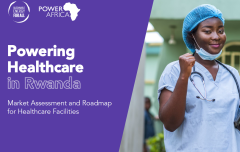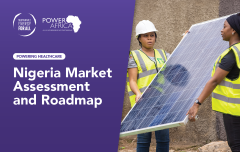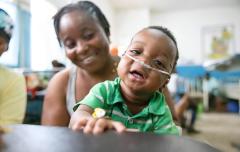New analysis details how Rwanda can electrify every healthcare facility across the country
Rwanda could achieve 100 percent electrification of its healthcare facilities by 2027 by using solar power and backup batteries to electrify currently unelectrified health posts, according to the latest report Powering Healthcare in Rwanda: Market Assessment and Roadmap for Healthcare Facilities by SEforALL in consultation with EnGreen.
Developed with support from Power Africa, this report aims to provide the government and its development partners with data on the scale of the remaining energy gap in the healthcare sector, and options of long-term sustainable models and estimates of investment needed for delivery of continuous and reliable electricity service.
Of the 2,139 health facilities in the country, 85 percent (1,813) are connected to the grid. This figure includes all the secondary and tertiary health centres - all of which have a battery backup - and 74 percent of the health posts. A third of the remaining health posts is already powered by standalone solar PV systems, leaving a total of 229 health posts without access to a reliable and renewable electricity source.
This creates a market opportunity to connect these health posts to solar PV systems, phase out diesel generators, as well as provide better battery backup for the other health facilities. USD 10 million would be needed to achieve these outcomes, as defined in the report’s “roadmap” – USD 1.5 million for standalone PV systems in off-grid health posts and USD 8.5 million for battery backup in grid-connected health facilities.
“Rwanda’s government has made remarkable progress in ensuring health facility electrification is, and remains, a priority, and new and innovative financing mechanisms are now needed to sustain this development,” said Luc Severi, who manages the Powering Healthcare programme at SEforALL. “This roadmap also provides valuable insights into how we can bring life-saving power solutions to the remaining unelectrified health facilities in Rwanda.”
Historically, international donors have been funding off-grid pilot projects, but moving forward, leveraging private investments can help close the financing gap. Scaling up projects, innovative financing and other mechanisms like public-private partnerships, compensation and subsidies are necessary to attract such investments.
The report covers various such aspects of healthcare facility electrification in Rwanda and finally draws out four key challenges to address, along with recommendations, for the country to achieve its health facility electrification goals:
- Ensuring continued effective internal and external coordination between all key stakeholders including the various government ministries and donors.
- Creating an enabling environment for private sector engagement through mechanisms like public-private partnership (PPP), compensation, subsidies and other de-risking instruments.
- Ensuring access to reliable data about the sector.
- Allocating adequate resources for operation, maintenance and training to ensure reliability and security of the electricity supply and enable high-level healthcare services.
Rwanda’s governmental expenditure on healthcare as a share of its overall expenditure is above the average spending of countries in Sub-Saharan Africa. Given this level of commitment and its ambition to achieve 100 percent electrification by 2024, and supported by the right kind of investment, Rwanda can become a trailblazer in fully powering its healthcare facilities with clean and reliable electricity, positively impacting millions of lives.
Musabyimana Nadine works as a nurse at the Nyamisa health post in the village Mubuga in Rwanda. The health post had no access to electricity until it was recently solarised, and it now has electricity around the clock.
“The clinic would become dysfunctional after dark, but we cannot control when a woman goes into labour,” says Musabyimana. “We used to deliver babies with great difficulty using phone torches and run lab tests without light. Many thanks to solar, we don’t have to do that anymore.”
More electrification projects like the one in Mubuga are needed, and this new study seeks to guide similar efforts. The research includes contributions from key stakeholders like Rwanda's Ministry of Health (MoH), Ministry of Infrastructure (MININFRA), Rwanda Energy Group Limited (REG) and its two subsidiaries, the Energy Utility Corporation Limited (EUCL) and Energy Development Corporation Limited (EDCL), UNDP and other organisations working on powering social infrastructure in Rwanda.



